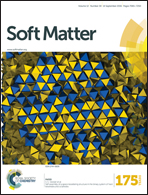Adhesion and non-linear rheology of adhesives with supramolecular crosslinking points†
Abstract
Soft supramolecular materials are promising for the design of innovative and highly tunable adhesives. These materials are composed of polymer chains functionalized by strongly interacting moieties, sometimes called “stickers”. In order to systematically investigate the effect of the presence of associative groups on the debonding properties of a supramolecular adhesive, a series of supramolecular model systems has been characterized by probe-tack tests. These model materials, composed of linear and low dispersity poly(butylacrylate) chains functionalized in the middle by a single tri-urea sticker, are able to self-associate by six hydrogen bonds and range in molecular weight (Mn) between 5 and 85 kg mol−1. The linear rheology and the nanostructure of the same materials (called “PnBA3U”) were the object of a previous study. At room temperature, the association of polymers via hydrogen bonds induces the formation of rod-like aggregates structured into bundles for Mn < 40 kg mol−1 and the behavior of a soft elastic material was observed (G′ ≪ G′′ and G′ ∼ ω0). For higher Mn materials, the filaments were randomly oriented and the polymers displayed a crossover towards viscous behavior although terminal relaxation was not reached in the experimental frequency window. All these materials show, however, similar adhesive properties characterized by a cohesive mode of failure and low debonding energies (Wadh < 40 J m−2 for a debonding speed of 100 μm s−1). The debonding mechanisms observed during the adhesion tests have been investigated in detail with an Image tools analysis developed by our group. The measure of the projected area covered by cavities growing in the adhesive layer during debonding can be used to estimate the true stress in the walls of the cavities and thus to characterize the in situ large strain deformation of the thin layer during the adhesion test itself. This analysis revealed in particular that the PnBA3U materials with Mn < 40 kg mol−1 soften very markedly at large deformation like yield stress fluids, explaining the low adhesion energies measured for these viscoelastic gels.


 Please wait while we load your content...
Please wait while we load your content...